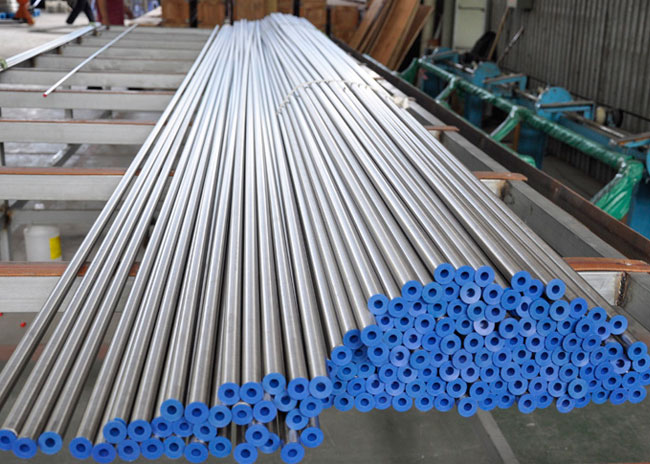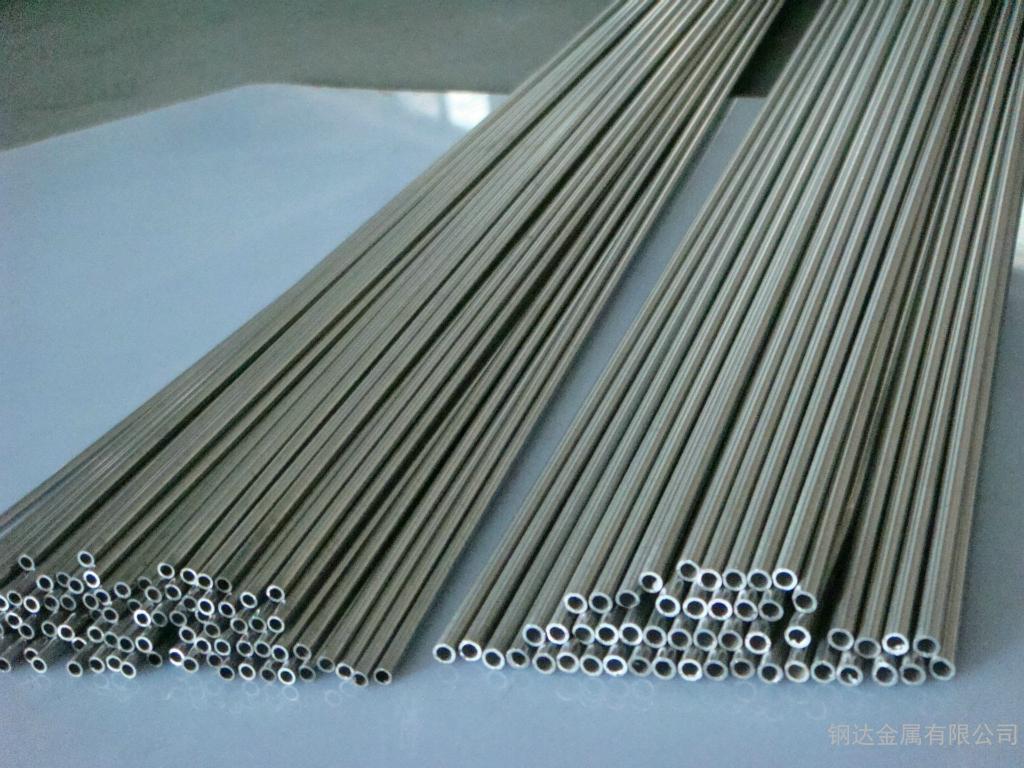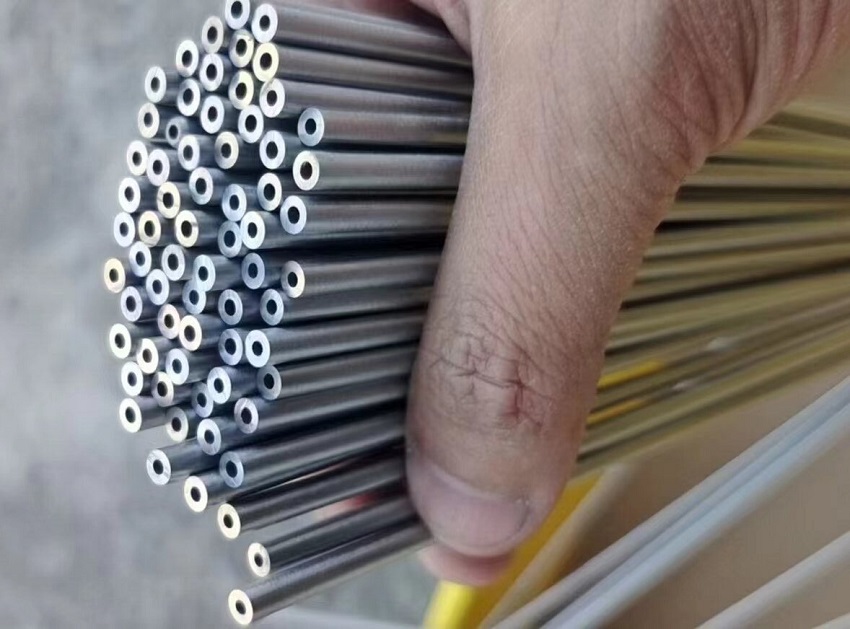What is stainless steel hydraulic tubing?
|
Stainless Steel Grade |
Chemical Composition (%) |
|
304 Stainless Steel |
- Carbon (C): ≤ 0.08%- Silicon (Si): ≤ 1.00%- Manganese (Mn): ≤ 2.00%- Phosphorus (P): ≤ 0.045%- Sulfur (S): ≤ 0.030%- Chromium (Cr): 18.0-20.0%- Nickel (Ni): 8.0-10.5% |
|
316 Stainless Steel |
- Carbon (C): ≤ 0.08%- Silicon (Si): ≤ 1.00%- Manganese (Mn): ≤ 2.00%- Phosphorus (P): ≤ 0.045%- Sulfur (S): ≤ 0.030%- Chromium (Cr): 16.0-18.0%- Nickel (Ni): 10.0-14.0%- Molybdenum (Mo): 2.0-3.0% |
|
316L Stainless Steel |
- Carbon (C): ≤ 0.03%- Silicon (Si): ≤ 1.00%- Manganese (Mn): ≤ 2.00%- Phosphorus (P): ≤ 0.045%- Sulfur (S): ≤ 0.030%- Chromium (Cr): 16.0-18.0%- Nickel (Ni): 10.0-14.0%- Molybdenum (Mo): 2.0-3.0% |
|
Duplex Stainless Steel (UNS S31803) |
- Carbon (C): ≤ 0.030%- Silicon (Si): ≤ 1.00%- Manganese (Mn): ≤ 2.00%- Phosphorus (P): ≤ 0.030%- Sulfur (S): ≤ 0.020%- Chromium (Cr): 21.0-23.0%- Nickel (Ni): 4.5-6.5%- Molybdenum (Mo): 2.5-3.5%- Nitrogen (N): 0.08-0.20% |
|
Super Duplex Stainless Steel (UNS S32750) |
- Carbon (C): ≤ 0.030%- Silicon (Si): ≤ 0.80%- Manganese (Mn): ≤ 1.20%- Phosphorus (P): ≤ 0.035%- Sulfur (S): ≤ 0.020%- Chromium (Cr): 24.0-26.0%- Nickel (Ni): 6.0-8.0%- Molybdenum (Mo): 3.0-5.0%- Nitrogen (N): 0.24-0.32% |
|
Tube Size (Outside Diameter) |
Metric (mm) |
Imperial (inch) |
Wall Thickness (Metric) |
Wall Thickness (Imperial) |
|
6 mm |
1/4 inch |
1.0 mm |
0.035 inch |
|
|
8 mm |
5/16 inch |
1.0 mm |
0.035 inch |
|
|
10 mm |
3/8 inch |
1.0 mm |
0.035 inch |
|
|
12 mm |
1/2 inch |
1.0 mm |
0.035 inch |
|
|
15 mm |
5/8 inch |
1.5 mm |
0.049 inch |
|
|
16 mm |
5/8 inch |
1.5 mm |
0.049 inch |
|
|
20 mm |
3/4 inch |
1.5 mm |
0.049 inch |
|
|
22 mm |
7/8 inch |
2.0 mm |
0.065 inch |
|
|
25 mm |
1 inch |
2.0 mm |
0.065 inch |
|
|
28 mm |
1-1/8 inch |
2.0 mm |
0.065 inch |
|
|
30 mm |
1-1/4 inch |
2.0 mm |
0.065 inch |
|
|
32 mm |
1-1/4 inch |
2.0 mm |
0.065 inch |
|
|
35 mm |
1-3/8 inch |
2.0 mm |
0.065 inch |
|
|
38 mm |
1-1/2 inch |
2.0 mm |
0.065 inch |
|
|
40 mm |
1-1/2 inch |
2.0 mm |
0.065 inch |
|
|
45 mm |
1-3/4 inch |
2.0 mm |
0.065 inch |
|
|
50 mm |
2 inch |
2.0 mm |
0.065 inch |
|
Surface Finish Type |
Description |
|
Bright Annealed |
- A smooth, shiny surface finish achieved through annealing in a controlled atmosphere furnace.- Provides excellent corrosion resistance and aesthetic appeal.- Ideal for applications requiring a high-quality, polished appearance. |
|
Pickled and Passivated |
- The tubing is chemically treated to remove surface impurities, scale, and contaminants (pickling), followed by passivation to enhance corrosion resistance.- Results in a clean, uniform surface finish with improved corrosion resistance.- Suitable for applications where cleanliness and corrosion resistance are critical, such as pharmaceutical and food processing industries. |
|
Mechanical Polished |
- Achieved through mechanical polishing processes such as grinding, buffing, or brushing.- Provides a smooth, satin-like finish with enhanced aesthetic appeal.- Suitable for applications requiring a decorative finish, such as architectural and ornamental applications. |
|
Electropolished |
- An electrochemical process that removes surface imperfections and enhances the chromium oxide layer on the stainless steel surface.- Produces a smooth, mirror-like finish with improved corrosion resistance and cleanability.- Ideal for applications requiring high cleanliness, such as semiconductor and biopharmaceutical industries. |
|
Matte Finish |
- A non-reflective, dull surface finish achieved through abrasive blasting or chemical etching.- Provides a uniform, textured appearance with reduced glare and reflection.- Suitable for applications where aesthetics and glare reduction are important, such as outdoor architectural elements and signage. |
|
Heat Treatment Process |
Description |
|
Annealing |
- Annealing is a heat treatment process that involves heating the stainless steel tubing to a specific temperature, typically above its recrystallization temperature, and then cooling it slowly to room temperature.- This process relieves internal stresses, improves ductility, and enhances the materials mechanical properties.- Annealing is commonly used to soften the stainless steel tubing for further processing, such as bending or forming. |
|
Quenching and Tempering |
- Quenching involves rapidly cooling the stainless steel tubing from a high temperature, typically by immersing it in a quenching medium such as oil or water.- Tempering is then performed by reheating the quenched tubing to a lower temperature to achieve the desired balance of hardness and toughness.- This process improves the tubings hardness, strength, and resistance to wear and abrasion.- Quenching and tempering are commonly used for strengthening stainless steel tubing in high-pressure hydraulic applications. |
|
Solution Annealing |
- Solution annealing, also known as solution treatment, is a heat treatment process used for austenitic stainless steel tubing grades such as 304 and 316.- It involves heating the tubing to a temperature above its critical temperature range to dissolve any carbides or other precipitates present in the material.- The tubing is then rapidly cooled to prevent the reformation of carbides, resulting in a single-phase austenitic microstructure with improved corrosion resistance and mechanical properties.- Solution annealing is often performed before welding or other fabrication processes to restore the tubings properties and prevent sensitization. |
|
Regulatory Standard |
Description |
|
ASTM A269 |
- ASTM A269 is a standard specification for seamless and welded austenitic stainless steel tubing for general service.- It covers tubing dimensions, mechanical properties, and testing requirements.- ASTM A269 tubing is commonly used in hydraulic systems, instrumentation, and process piping applications. |
|
ASTM A213/A269 |
- ASTM A213/A269 covers seamless ferritic and austenitic stainless steel tubing for boiler, superheater, and heat-exchanger applications.- It specifies dimensions, mechanical properties, and testing requirements for tubing used in high-temperature and corrosive environments.- ASTM A213/A269 tubing is suitable for hydraulic systems operating under elevated temperatures and pressures. |
|
ASTM A789/A790 |
- ASTM A789/A790 covers seamless and welded duplex stainless steel tubing for general corrosion resistance and high-strength applications.- It specifies dimensions, mechanical properties, and testing requirements for duplex stainless steel tubing used in aggressive environments.- ASTM A789/A790 tubing is commonly used in hydraulic systems in marine, offshore, and chemical processing industries. |
|
ISO 1127 |
- ISO 1127 is an international standard for stainless steel tubing dimensions, tolerances, and surface finish requirements.- It provides specifications for both seamless and welded stainless steel tubing used in various industries, including hydraulic systems.- ISO 1127 ensures compatibility and interchangeability of stainless steel tubing from different manufacturers. |
|
NACE MR0175/ISO 15156 |
- NACE MR0175/ISO 15156 is a standard addressing the resistance of metallic materials to sulfide stress cracking in sour environments containing H2S.- It specifies material requirements, including chemical composition, hardness, and heat treatment, for tubing used in oil and gas production, including hydraulic systems.- NACE MR0175/ISO 15156 compliance is essential for tubing used in sour service applications. |

Stainless steel hydraulic tubing
请输入搜索关键字
确定






